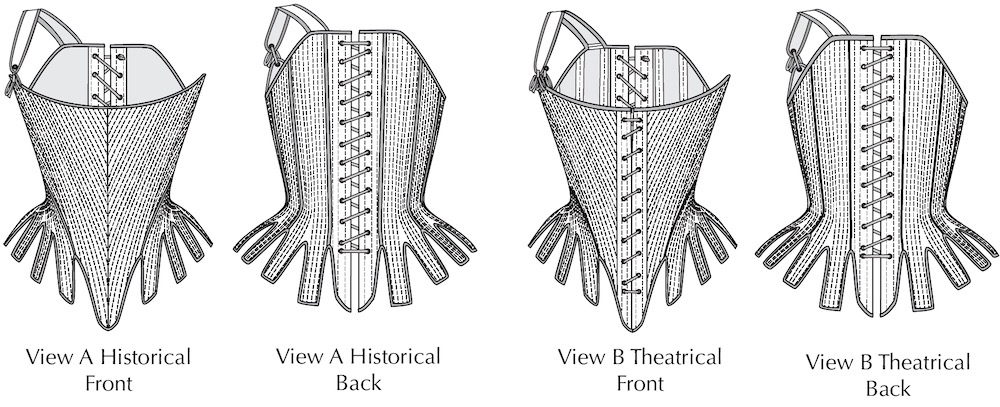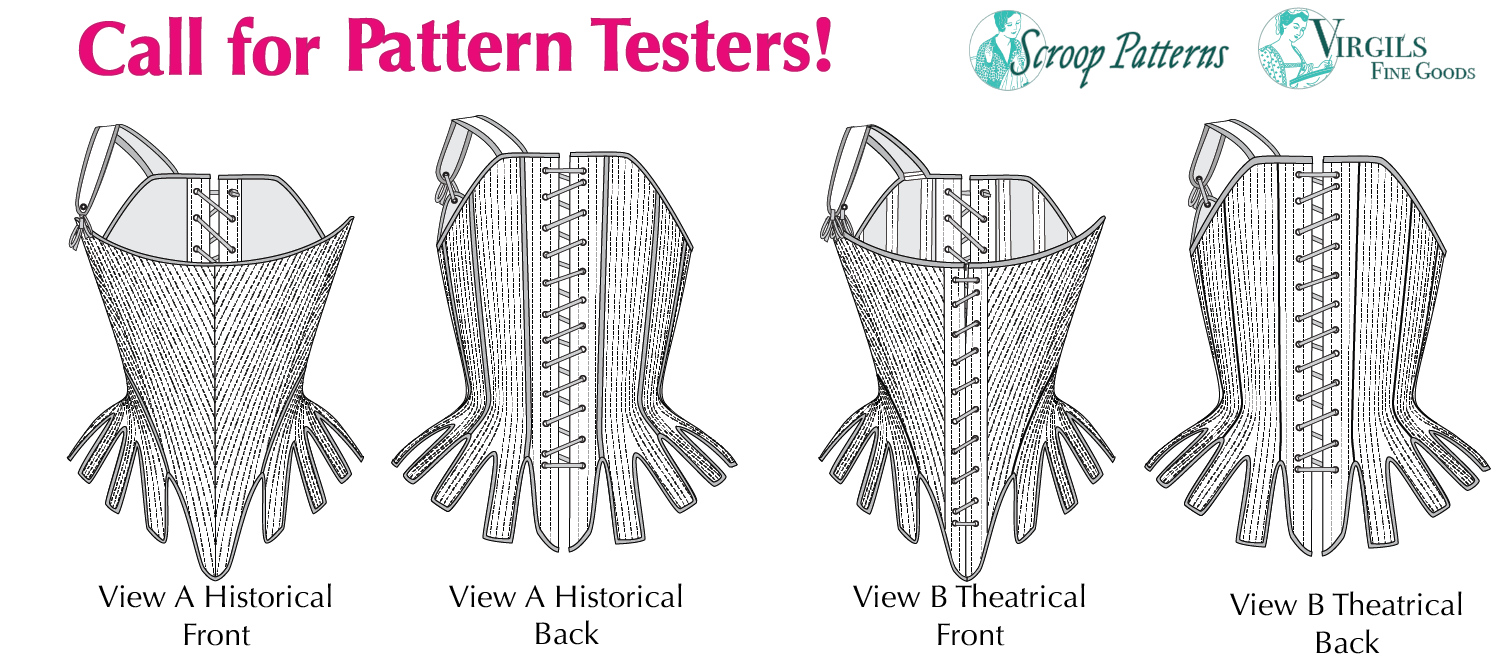UPDATE: Thank you to all who applied! Applications to test the pattern are now closed.
Amber of Virgil’s Fine Goods and I are adding to the Scroop + Virgil’s Fine Goods Pattern offerings, and have another exciting 18th century pattern almost finished! We’re looking for testers to help us check the final fit and instruction details. 💛
If you’d like to be one of them, keep reading to learn more, and how to apply!
This testing round will run Sat 11 Nov-Wed 3 Jan, with a check in midway. We know that’s a very busy time of year for some people, but a very slow time for others (Leimomi waves hi!). Please consider how busy this time of year is for you before you apply: there will be other patterns to test, and we’d hate for this to be another stressor at what is already a stressful time for some!
The Pattern:
Our Augusta Stays pattern has been wildly popular, and we get requests for another stays pattern all the time. The things most often asked for are earlier 1760s-70s stays and front lacing stays. Inspired by this, we’ve created a pattern based on a number of extant 1760s-70s stays!
View A: Historical has a closed front and fully handsewn, historically accurate instructions. View B: Theatrical has front and back lacing, and primarily machine-sewn instructions based on theatrical construction techniques.

Both views use a combination of 4mm and 6mm synthetic whalebone boning, and have a cane bust rail to help achieve the very curved, rounded bust fashionable in this period. Both views can be made with or without straps.
It is possible to make either version with a mix of the historical and theatrical instructions.
The pattern will be available in the full Scroop + Virgil’s Size Range of 30”/76cm bust to 52”/132cm bust. Like the Augusta Stays, it will come in a ‘Straight’ and ‘Curvy’ option.

Materials:
Please check that you’ll be able to get the appropriate materials to test. This pattern uses approximately:
Both Versions:
- 27½ yards/25 meters of 4mm x 1mm synthetic whalebone
- 4½ yards/4 meters of 6mm x 1.5mm synthetic whalebone
- Bust rail: 1 yard/90cm 7mm round cane.
View A Historical Version:
1.5 yards/1m of each of the following:
-
- Layer 1: Outer: Tightly woven mid-weight linens, silks, and worsted wools, in plain and twill weaves.
- Layer 2: Interlining 1: Heavyweight linen.
- Layer 3: Interlining 2: Linen buckram: make your own with heavyweight linen and gum tragacanthe or xantham gum, following this tutorial
- Layer 4: Lining (OPTIONAL): Lightweight linen. Checks and stripes are seen in many extant examples.
Plus:
-
- Binding: 8 yards/7 meters of ¾”/2cm wide linen tape OR ½”/1.2cm wide strips of thin leather.
- Seam tape (OPTIONAL): 5 yards/4 meters ¼”/6mm wide linen tape.
- Lacing cord: 3 yards/2.5 meters linen lacing cord.
- Thread: 60/2 and 80/3 linen thread, or quilter‘s cotton thread.
- Gum Tragacanthe or Xantham Gum: to make linen buckram.
View B Historical Version:
1.5 yards/1m of each of the following:
-
- Layer 1: Decorative Outer (OPTIONAL): Light-midweight natural-fiber fabrics such as damask, brocade, fancy cottons, or linen.
- Layer 2: Support Outer: Midweight, very tightly woven, extremely stable, natural-fiber fabrics with no stretch or give, such as heavy poplin, cotton sateen, coutil, satin or brocaded coutil, ticking, mid-heavyweight linen, etc. The heavier and sturdier the fabric used for Layer 1 is, the lighter the fabric used for Layer 2 should be
- Layer 3:Support Inner: Midweight, very tightly woven, extremely stable, natural-fiber fabrics with no stretch or give, such as coutil, satin or brocaded coutil, ticking, heavyweight linen, etc.
Plus:
-
- Bias Binding: 6 yards/5 meters of 1¼”/3cm wide bias-cut strips of tightly-woven midweight fabric.
- Lacing cord: 4.5 yards/4 meters cotton lacing cord.
- Grommets: 46 Size 00 two-part (grommets + washers).
- Aiglet: 2x Metal aiglet.
Testers:
This is an advanced pattern, and we’re looking for testers with prior historical sewing experience, OR extensive non-historical sewing experience.
To be a tester you will need to:
- Be able to print patterns in A4, A0, US Letter or US full sized Copyshop paper sizes.
- Be aged 21 or over.
- Have the time to sew up the item. You’ll have a month to sew a toile and check the initial fit. This can be done by machine, and takes Leimomi less than 7 hours from fabric to finished (at least 90 minutes of this was cutting bones, which can be re-used in your final stays). You’ll then have a further four-ish weeks to make finished stays, photograph them, and provide feedback.
- Be able to photograph your make being worn, and be willing for us to share your photos on this blog and instagram.
- Provide clear feedback.
- Agree to a confidentially agreement regarding the pattern.
We would hugely appreciate it if testers would share their finished make once the pattern launches, but this is not mandatory. We’re asking for TESTERS, not marketers.
As always we’re looking for a range of testers. We need a spread of geographical location, body type, sewing experience, and personal style.
Based on previous calls for testers, we will get 30+ applicants in each of the most common size ranges (34-40 bust), so if we don’t choose you, it’s not that you weren’t fabulous, it’s that there were many applicants.
The Timeline:
Materials:
If you’re selected to test we’ll let you know and send you the materials requirements, line drawings, and the full pattern description by 10 pm NZ time on Tue the 24th of Oct. This is Mon the 23rd for most of the rest of the world.
Patterns:
We will send out a digital copy of the pattern to testers before 10pm NZ time on Sat 11 Nov.
Testing & Reviewing:
As this is a pretty time intensive pattern, testing will go for seven weeks, with a toile check in one month in.
Testers will have until 10pm NZ time on Mon 11 Dec to do an initial toile of the stays and respond to the initial set of testing questions.
We’ll need testers to provide final feedback by 10pm NZ time on Wed 3 Jan. They will need to be finished with their stays and provide photos by 10pm on Mon 8 Jan.
What you get:
Pattern testers will get a digital copy of all three size packs of the final pattern, lots of thanks, and features on my blog and our IGs.
Testing also offers testers an opportunity to get group and 1-1 feedback, assistance, and sewing tutorials from Amber and I. It’s similarly to what you’d get in an online sewing workshop. We’re modelling our testing process after an online class, albeit one you don’t pay for, because you’re letting us beta test the pattern on you. There’s an online group that testers can join as they wish. We’ll also be running a couple of live zoom events. We’re committed to making testing as beneficial to testers as it is to us, and improve our testing process with every pattern we do.
Testers chosen from this open call are not paid.
Hope to hear from you!
To Apply to be a Tester:
Sorry, applications to test this pattern are now closed


I would like to be a tester! I am an historical reenactor from Barcelona, Spain (I haver dresses from 1950 to 1780) I have corsetry notions (I went to Sew Curvy next to Oxford to learn basis and I made and stage at Bibian Blue) and corsets and stays are my passion! I sew fantasy and steampunk dresses too.
Great! Just fill out the application form that is linked at the bottom.
I can’t wait for this pattern to be finished! I can’t apply as a tester though, since I have a planned surgery coming up that will need both recovery and will result in some body altering in that time, otherwise I would have jumped on it.
Yay! This is so exciting! It’s great to see another Scroop pattern upcoming, be it modern, or historical. I’m always telling friends about Scroop, even the occasional random person too. Your patterns make up a lot of my wardrobe.